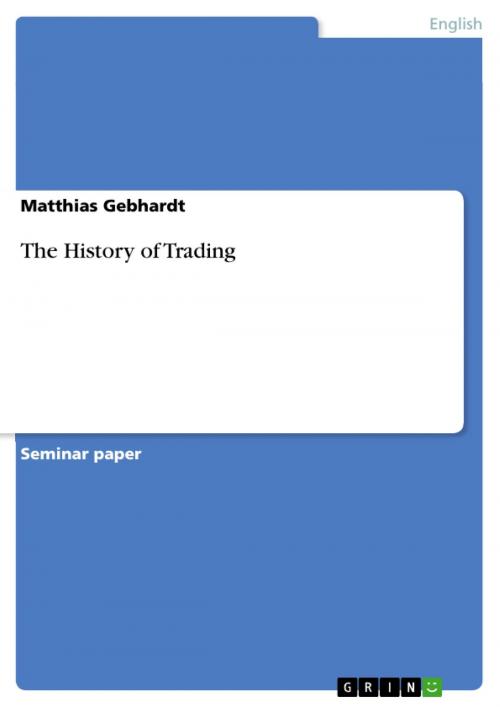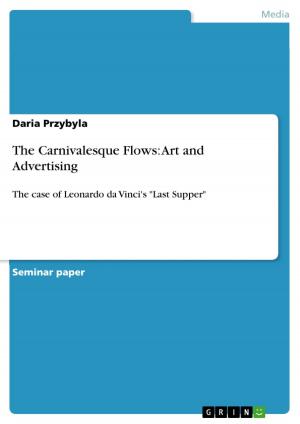| Author: | Matthias Gebhardt | ISBN: | 9783638589505 |
| Publisher: | GRIN Publishing | Publication: | January 8, 2007 |
| Imprint: | GRIN Publishing | Language: | English |
| Author: | Matthias Gebhardt |
| ISBN: | 9783638589505 |
| Publisher: | GRIN Publishing |
| Publication: | January 8, 2007 |
| Imprint: | GRIN Publishing |
| Language: | English |
Seminar paper from the year 2004 in the subject English Language and Literature Studies - Culture and Applied Geography, grade: 2,0, Technical University of Braunschweig (Englisches Seminar - Abteilung Englische Sprache und ihre Didaktik), course: From Reformation to Restauration, 3 entries in the bibliography, language: English, abstract: When people exchanged some items for other ones the first time, trade had come into this world. As the relationship between the one who is in need of a certain thing and the one who can provide the required item proved quite profitable for the latter, people established particular professions like farmers, carpenters, fishermen, miners, etc. in order to be able to trade on a regular basis. An example of a series of connected professions might be a farmer, who specialized in growing wheat and giving it to a mill in return for money or, of course, flour. The miller could then sell the flour to a bakery where bread was baked and sold again. Regarding all the different trades it was nearly always the selling person who set the conditions as he could take advantage of the other one's desire or need for the respective goods. Within the 11th and 12th century people in England began to gather in cooperative unions. The guilds, as they were called, always consisted of members of one special profession. They had several aims such as promoting the welfare of their members, preserving the craft tradition, holding a local monopoly and maintaining the standards of work and the level of wages and prices. The guilds were mostly only interested in trading within their direct vicinity in keeping with their traditions which left no room for changes, neither in the use of certain tools or the way of proceeding nor in the way apprentices were instructed. Throughout the centuries the people dealt with several goods within villages and furthermore within counties and boroughs, and also beyond that: with other countries. England exported goods to the 'continent' and imported other items which also came from manufacturers that belonged to guilds in e.g. France or today's Germany. Different conditions in the country and law enforcement by the government influenced the trades again and again. Especially the Statute of Artificers, introduced during the reign of queen Elisabeth I, had a tremendous impact on the trades and on apprenticeship. There were several changes regarding the ways of producing goods as well as trading in them. This paper wants to give a description of the changes in medieval England concerning the changes in the national economy. Special emphasis is put on the Statute of Artificers and on one of its so-called precursors: the Acte touching weavers.
Seminar paper from the year 2004 in the subject English Language and Literature Studies - Culture and Applied Geography, grade: 2,0, Technical University of Braunschweig (Englisches Seminar - Abteilung Englische Sprache und ihre Didaktik), course: From Reformation to Restauration, 3 entries in the bibliography, language: English, abstract: When people exchanged some items for other ones the first time, trade had come into this world. As the relationship between the one who is in need of a certain thing and the one who can provide the required item proved quite profitable for the latter, people established particular professions like farmers, carpenters, fishermen, miners, etc. in order to be able to trade on a regular basis. An example of a series of connected professions might be a farmer, who specialized in growing wheat and giving it to a mill in return for money or, of course, flour. The miller could then sell the flour to a bakery where bread was baked and sold again. Regarding all the different trades it was nearly always the selling person who set the conditions as he could take advantage of the other one's desire or need for the respective goods. Within the 11th and 12th century people in England began to gather in cooperative unions. The guilds, as they were called, always consisted of members of one special profession. They had several aims such as promoting the welfare of their members, preserving the craft tradition, holding a local monopoly and maintaining the standards of work and the level of wages and prices. The guilds were mostly only interested in trading within their direct vicinity in keeping with their traditions which left no room for changes, neither in the use of certain tools or the way of proceeding nor in the way apprentices were instructed. Throughout the centuries the people dealt with several goods within villages and furthermore within counties and boroughs, and also beyond that: with other countries. England exported goods to the 'continent' and imported other items which also came from manufacturers that belonged to guilds in e.g. France or today's Germany. Different conditions in the country and law enforcement by the government influenced the trades again and again. Especially the Statute of Artificers, introduced during the reign of queen Elisabeth I, had a tremendous impact on the trades and on apprenticeship. There were several changes regarding the ways of producing goods as well as trading in them. This paper wants to give a description of the changes in medieval England concerning the changes in the national economy. Special emphasis is put on the Statute of Artificers and on one of its so-called precursors: the Acte touching weavers.















